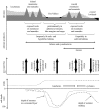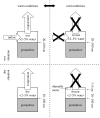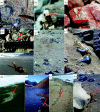Controls on the distribution of productivity and organic resources in Antarctic Dry Valley soils
- PMID: 17015369
- PMCID: PMC1635502
- DOI: 10.1098/rspb.2006.3595
Controls on the distribution of productivity and organic resources in Antarctic Dry Valley soils
Abstract
The Antarctic Dry Valleys are regarded as one of the harshest terrestrial habitats on Earth because of the extremely cold and dry conditions. Despite the extreme environment and scarcity of conspicuous primary producers, the soils contain organic carbon and heterotrophic micro-organisms and invertebrates. Potential sources of organic compounds to sustain soil organisms include in situ primary production by micro-organisms and mosses, spatial subsidies from lacustrine and marine-derived detritus, and temporal subsidies ('legacies') from ancient lake deposits. The contributions from these sources at different sites are likely to be influenced by local environmental conditions, especially soil moisture content, position in the landscape in relation to lake level oscillations and legacies from previous geomorphic processes. Here we review the abiotic factors that influence biological activity in Dry Valley soils and present a conceptual model that summarizes mechanisms leading to organic resources therein.
Figures




Similar articles
-
Functional ecology of an Antarctic Dry Valley.Proc Natl Acad Sci U S A. 2013 May 28;110(22):8990-5. doi: 10.1073/pnas.1300643110. Epub 2013 May 13. Proc Natl Acad Sci U S A. 2013. PMID: 23671121 Free PMC article.
-
Sources of edaphic cyanobacterial diversity in the Dry Valleys of Eastern Antarctica.ISME J. 2008 Mar;2(3):308-20. doi: 10.1038/ismej.2007.104. Epub 2008 Jan 31. ISME J. 2008. PMID: 18239611
-
Isotopic evidence for the provenance and turnover of organic carbon by soil microorganisms in the Antarctic dry valleys.Environ Microbiol. 2009 Mar;11(3):597-608. doi: 10.1111/j.1462-2920.2008.01830.x. Environ Microbiol. 2009. PMID: 19278446
-
On the rocks: the microbiology of Antarctic Dry Valley soils.Nat Rev Microbiol. 2010 Feb;8(2):129-38. doi: 10.1038/nrmicro2281. Nat Rev Microbiol. 2010. PMID: 20075927 Review.
-
Extracellular Enzymes and Bioactive Compounds from Antarctic Terrestrial Fungi for Bioprospecting.Int J Environ Res Public Health. 2020 Sep 4;17(18):6459. doi: 10.3390/ijerph17186459. Int J Environ Res Public Health. 2020. PMID: 32899827 Free PMC article. Review.
Cited by
-
Functional ecology of an Antarctic Dry Valley.Proc Natl Acad Sci U S A. 2013 May 28;110(22):8990-5. doi: 10.1073/pnas.1300643110. Epub 2013 May 13. Proc Natl Acad Sci U S A. 2013. PMID: 23671121 Free PMC article.
-
At limits of life: multidisciplinary insights reveal environmental constraints on biotic diversity in continental Antarctica.PLoS One. 2012;7(9):e44578. doi: 10.1371/journal.pone.0044578. Epub 2012 Sep 19. PLoS One. 2012. PMID: 23028563 Free PMC article.
-
Rapid Microbial Dynamics in Response to an Induced Wetting Event in Antarctic Dry Valley Soils.Front Microbiol. 2019 Apr 4;10:621. doi: 10.3389/fmicb.2019.00621. eCollection 2019. Front Microbiol. 2019. PMID: 31019494 Free PMC article.
-
Taxonomic and Functional Diversity of Soil and Hypolithic Microbial Communities in Miers Valley, McMurdo Dry Valleys, Antarctica.Front Microbiol. 2016 Oct 20;7:1642. doi: 10.3389/fmicb.2016.01642. eCollection 2016. Front Microbiol. 2016. PMID: 27812351 Free PMC article.
-
Bacterial community structure along moisture gradients in the parafluvial sediments of two ephemeral desert streams.Microb Ecol. 2011 Apr;61(3):543-56. doi: 10.1007/s00248-010-9782-7. Epub 2010 Dec 9. Microb Ecol. 2011. PMID: 21153024
References
-
- Adams, B. J., Bardgett, R. D., Ayres, E., Wall, D. H., Aislabie, J., Bamforth, S., Bargagli, R., Cary, C., Cavacini, P., Connell, L., Convey, P., Fell, J. W., Frati, F., Hogg, I. D., Newsham, K. K., O'Donnell, A., Russell, N., Seppelt, R. D. & Stevens, M. I. In press. Diversity and distribution of Victoria Land biota. Soil Biol. Biochem (doi:10.1016/j.soilbio.2006.04.030) - DOI
-
- Alfinito S, Fumanti B, Cavacini P. Epiphytic algae on mosses from northern Victoria Land, Antarctica. Nova Hedwigia. 1998;66:473–480.
-
- Bargagli R, Smith R.I.L, Martella L, Monaci F, Sanchez-Hernandez J.C, Ugolini F.C. Solution geochemistry and behaviour of major and trace elements during summer in a moss community at Edmonson Point, Victoria Land, Antarctica. Antarctic Sci. 1999;11:3–12.
-
- Barrett J.E, Virginia R.A, Wall D.H. Trends in resin and KCl-extractable soil nitrogen across landscape gradients in Taylor Valley, Antarctica. Ecosystems. 2002;5:289–299. doi:10.1007/s10021-001-0072-6 - DOI
-
- Barrett J.E, Virginia R.A, Wall D.H, Parsons A.N, Powers L.E, Burkins M.B. Variation in biogeochemistry and soil biodiversity across spatial scales in a polar desert ecosystem. Ecology. 2004;85:3105–3118.
Publication types
MeSH terms
Substances
LinkOut - more resources
Full Text Sources

